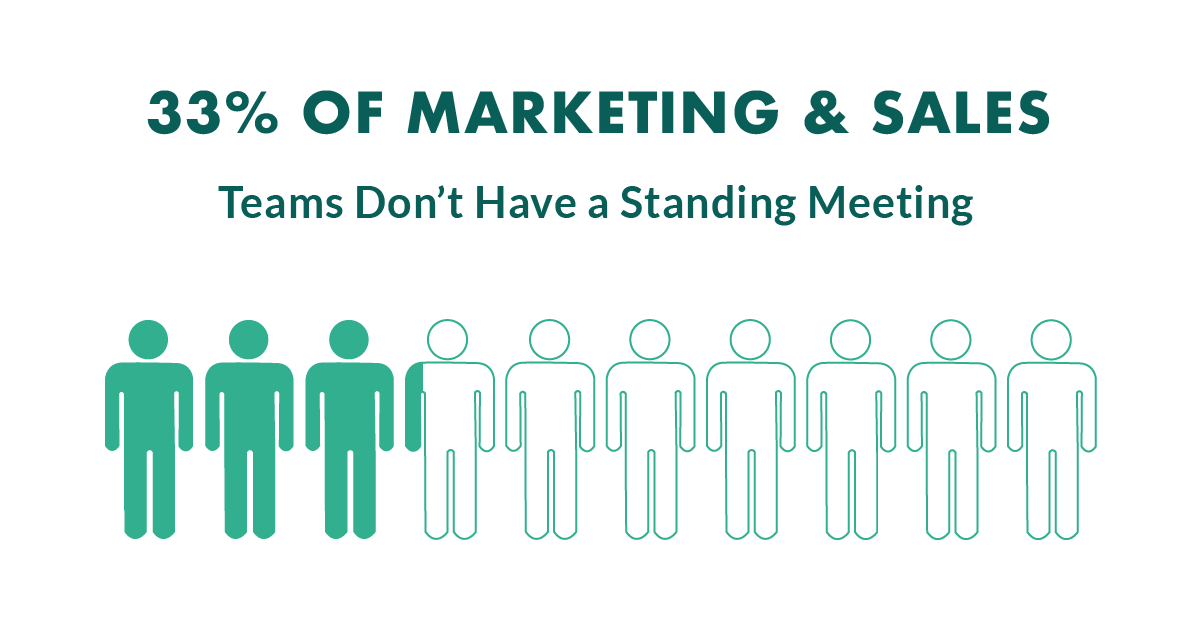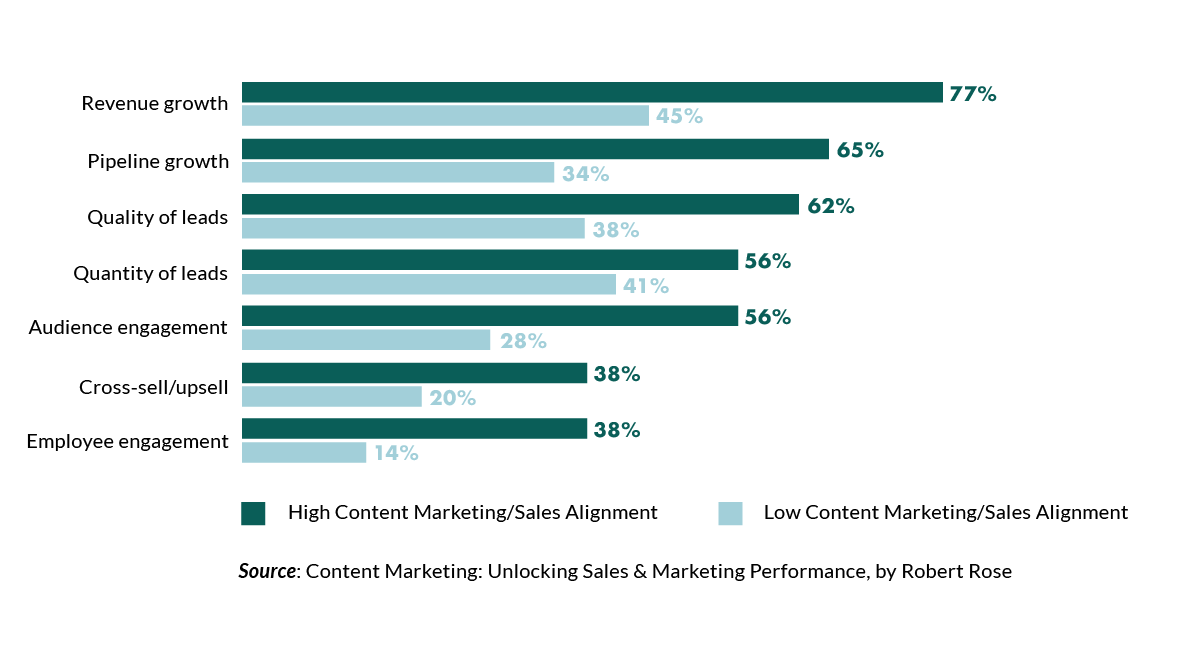I have been working in marketing for many years now.
One of my key concerns has always been to establish closer relationships with my colleagues in sales.
It’s not an easy task, as quite often sales and marketing seem to blame each other for not contributing enough.
For example, the sales department would complain that the marketing team is not giving them enough good quality leads, not enough content, not enough research, etc.
Meanwhile, we – the marketing people – would complain that sales are not efficiently using the wealth of lead nurturing materials that we create for them, or are simply unable to work with the “awesome” leads we generate, etc., etc.
A situation like this is no news to many companies. And even though everybody is trumpeting on every corner that salespeople and marketeers should work in a harmonious tandem, the reality is – they rarely see eye to eye.
For example, only 1/3 of salespeople think that marketing people know what sales need from them, meanwhile almost 60% of marketers think they know what salespeople require from them!
In this article I will try to take a closer look at why, instead of being “frenemies”, sales and marketing should bury the hatchet and find a common ground.
Sales-marketing friendship is a tricky thing
Nobody knows how and when it started, but … sales and marketing don’t always get along.
Despite sharing the common goals of creating value for customers and increasing a company’s revenue, the two teams seem to have very different views when it comes to understanding what a prospect or a customer needs. Not to mention, the goals that the two teams are after.
- Strategy vs. Practice. The difference in views can be compared to the difference between a war general who designs an attack strategy (marketing) and a soldier going into battle (sales).
- The big picture vs. The situation at hand. While marketers think in terms of segments, audiences, long-term projections and tendencies; salespeople think about relationships, individual buyers, immediate results and real life situations.
- Long-term vs. Short-term goals. Since sales need to hit their quarterly sales targets they reach out to marketing for regular help. Marketing, on the other hand, knows that short-term campaigns are inefficient, costly and take up resources from the long-term gains, such as brand building, positioning, organic traffic, etc. – i.e. the content that they “know” actually matters.
- Maximum profit vs. Realistic profit. Marketeers are preoccupied with reaching overall financial goals – that’s they’re interested to get the highest revenue from each customer and hate discounts. Meanwhile, salespeople have individual goals to attain (quotas). Being in the field, they are interested in actually selling something. That’s why for them offering discounts and lower prices can really help.
Not surprising that the friendship between marketing “thinkers” and sales “practitioners” is a tricky one.
Why should we even care if we get along or not?
Businesses would benefit greatly if sales and marketing worked in an aligned tandem.
But don’t take my word for it!
Times and again studies show that B2B organizations with properly aligned marketing and sales teams achieve a 20% annual growth rate, while less aligned companies report a 4% revenue decline.
 Tightly aligned sales and marketing teams help their companies to:
Tightly aligned sales and marketing teams help their companies to:
- increase sales win rates by 38%,
- become 67% better at closing deals,
- achieve 24% faster three-year revenue growth and 27% faster three-year profit growth.
But… despite all these lucrative advantages of sales-marketing alignment, the reality is quite different. The two teams are said to rarely communicate.

A LinkedIn survey showed that “60% of global respondents believed that misalignment between sales and marketing could damage financial performance.”
Meanwhile, Marketo & Reachforce stun with an even scarier statistics, claiming that at least $1 TRILLION dollars is lost annually due to misaligned B2B sales and marketing strategies.
So… if you don’t feel like losing trillions of dollars, you’d better do something soon to make your sales and marketing people like each other more!
5 tips on how to make sales and marketing see eye to eye
Friendship, just like marriage, is hard work. And cooperation is even a harder challenge!
People cooperate well under one condition: when they know it’s going to benefit them.
In the case of the marketing vs. sales discord, lack of communication, working in silos, having separate goals and KPIs – literally erode trust and willingness to cooperate.
So, what can be done to strike a friendship between sales and marketing?
1. Come up with common projects
Nothing unites people better than a common task aimed to solve problems of common interest.
That’s why participation in joint projects, especially the ones that are measured, is an effective way to bring the two teams together.
If sales and marketing share a common project – for example, drafting a yearly territory plan, formulating a new sales strategy, mapping out the lead management process, etc. – they will inevitably learn from each other. Each team’s everyday knowledge, real-life anecdotes and hands-on experience can help see their functions in different light.
For example, sales can help marketing to develop strategies that address real (not imaginary) customer needs and wishes. Marketing can help sales spend time strategically, follow the plan, and make more precise moves and actions as opposed to those based on gut-feelings or impulses.
2. Share common KPIs
Another “common project” that may draw the two teams closer is shared KPIs.
There are a number of metrics that marketing and sales can share and this way unite efforts to achieve a common goal. These are, for example, KPIs that measure:
- Average revenue per account,
- Pipeline (value of qualified opportunities),
- Average deal size,
- Sales cycle length,
- Number of products/modules in each deal,
- Social media reach, engagement and followers.
Research shows that highly-aligned teams share a set of common KPIs that prioritize revenue and pipeline growth.

3. Create visibility for results
This tip is great for putting an end to the annoying “blame game”.
When things go wrong or results are disappointing, sales and marketing like to point fingers at each other.
There is a certain degree of imbalance in sales-marketing visibility. I mean: while sales results are for everyone to see, discuss and … judge, the results of marketing efforts are not that visible most of the time. Often marketing is involved in rather complex, multi-step, long-term projects that are difficult to evaluate over a period of time, and it may seem like no one appreciates the effort.
One way to solve it is to introduce regular public performance updates for both teams (we do this at our Quarterly Pipeline Forum here at SuperOffice).
While, with sales it’s obviously the number of closed and lost sales and the actual revenue, for marketing this has often been the results of campaigns, for example: marketing ROI, click-through-rates, page views, marketing and sales qualified leads (MQLs and SQLs), customer engagement and acquisition rates – to name but a few.
No wonder there can be a misalignment! Instead, I would suggest to start talking about shared goals such as pipeline and revenue – and how marketing has contributed to these numbers.
Shared visibility will demonstrate how hard each team has been working, incite trust and mutual respect, as well as lead to constructive conversations and overall engagement.
4. Agree on who your ideal customer is
Another way to bring the two teams together is to ensure they use the same language and share the same concepts. One of the key problems is the difference in understanding of who is a good fit for your company’s offering.
The solution is pretty simple here: sit down and define who your ideal customer is. This will help the teams to understand each other better and see clearly how they can help each other.
Once two teams know exactly whom they’re targeting, the communication will become clearer and the efforts will be more aligned.
You need to agree on such things as a customer’s demographics (industry, job title, revenue levels, etc.), psychological profile (likes, preferences, habits, attitudes), and their challenges and needs (how we can solve their problems and value). Did you know that the overwhelming majority – 74% of B2B buyers – choose the salesperson who was first to add value and insight in their buying process?
Defining an ideal customer profile is not only a bonding exercise, but it helps the entire company to find its market niche.
5. Organize “play dates”
Finally, those who play together, stay together.
It’s not enough to make the two teams to participate in joint planning and training sessions. People need to get to know each other and simply have fun together.
From common celebrations of achievements and wins, to team building events and other socializations – having regular “play dates” pays off if you want to improve communication.
It’s also important to understand that communication and collaboration are highly interpersonal matters. This means you should work with people, not with problems. To minimize the rift between sales and marketing, you need to address human behavioral traits, such as isolation, stubbornness, resistance to change, inability to listen, etc.
An organizational change
In order to put an end to the “them vs. us” mentality, you need to remove the barriers that separate sales and marketing, and help them communicate, support each other, and contribute to the overlapping projects and processes more.
It’s an organizational and cultural change that is required, in order to heal the rift between sales and marketing. But, without the full-hearted support of top management and the team leaders’ willingness to implement reforms, the situation won’t change. So, make sure all the “big bosses” are onboard.
However, don’t expect immediate results. It takes time for the friendship to evolve. So, be patient and carry on.
The future success of your company lies in your ability to bring the opposing camps together and make them start liking and respecting each other.
After all, a bad friendship is better than an all-out war, right?




